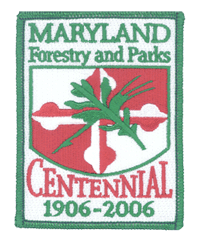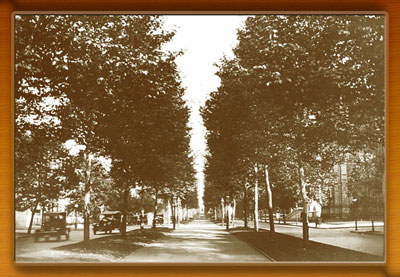 Scientific Forestry And Urban Progressivism:
Scientific Forestry And Urban Progressivism:
The Development of the Maryland Board of Forestry, 1906 to 1921 by Robert F. Bailey
Part 5: Conclusion and Epilogue
After struggling for several years to protect Maryland’s shrinking lumber reserves, the Forestry Board’s operating budget more than doubled in 1913. Besley’s willingness to accommodate the Baltimore region’s progressive impulses was critical to this development. By believing in the ultimate financial as well as environmental profitability of their endeavors, seeking government assistance, and trying to shape human behavior, the Forestry Board and urban progressives shared in an effort to expand the Patapsco Forest Reserve to further extant scientific forestry efforts, while meeting the
city’s need for clean water resources, and by providing its citizens—especially middle-class whites—with an additional outlet for recreation. Because it took on the role of managing an important suburban park, the Forestry Board’s role in the life of the City, the State and the people of Maryland provided it with a foundation to become a lasting State institution.

As the middle class embraced the automobile during the 1910s, the State government increasingly accommodated this shift. From 1908 to 1915, the State purchased and took control of the 19th-century turnpikes and began to fund efforts to rebuild them to suit autos. To appeal to the drivers’ aesthetic tastes (or perhaps to mold them), in 1914, the General Assembly passed a Roadside Tree Law to promote tree planting along Maryland’s public highways. In addition to planting trees, the law forbade the “unauthorized placing of advertisements and other notices.”79 The government commission appointed to enforce to provisions of the Roadside Tree Law was the State Board of Forestry.
It is ironic, however, that one of the primary motivations behind the Patapsco Reserve’s expansion centered on its potential contribution to suburbanization, the initial returns were modest. Catonsville, already Baltimore County’s largest suburb by 1900, would retain its exclusive character for several more decades—resisting a major expansion until the Post-World War II period. Moreover, the smaller community developments that Benson and others hoped would piggyback the Reserve’s expansion, remained modest-real estate ventures throughout this period. Indeed, Arbutus, Lansdowne and Halethorpe would retain their rural character for several more decades.
Undaunted by the slow pace of suburban development, the Board of Forestry in the 1920s solidified the Patapsco Valley’s connection with city park system by purchasing most of the private property east to the city line. As noted in this essay’s introduction, the Evening Sun noted April 17, “a continuous automobile drive through a State forest reserve of surpassing beauty will be the ultimate result if plans considered yesterday by Robert Garrett, member of the State Board of Forestry; State Forester F. W. Besley and other persons interested are completed.”80 Within a few years, automobilists from Baltimore City were driving down stretches of windy tree-lined roads to the park.
79 Buckley and Grove, 314. The law also included a provision for regularly spaced horse troughs, but with the advent of automobiles, the troughs were never put into place. Oakland Republican, April 8, 1920.
80 Baltimore Sun, Morning, April 17, 1921.
Bibliography
Primary Sources:
Maryland State Board of Forestry Publications:
Besley, F. W. The Forests of Garrett County. Baltimore, 1914.
Besley, F. W. The Forests of Maryland. Baltimore: 1916.
Maxwell, Hu. Wood-Using Industries of Maryland. Baltimore, 1910.
Report of the State Board of Forestry for 1906 and 1907. Baltimore, 1907.
Report of the State Board of Forestry for 1908 and 1909. Baltimore, 1909.
Report of the State Board of Forestry for 1910 and 1911. Baltimore, 1912.
Report of the State Board of Forestry for 1912 and 1913. Baltimore, 1913.
Report of the State Board of Forestry for 1914 and 1915. Baltimore, 1915.
Report of the State Board of Forestry for 1916 and 1917. Baltimore, 1917.
Report of the State Board of Forestry for 1920 and 1921. Baltimore, 1921.
Maryland State Department of Forestry Publications:
Besley, F. W. Facts About Maryland Forests. Baltimore, 1928.
Besley, F. W. Forest Trees of Maryland: How to Know Them. Baltimore, 1938.
Report of the State Department of Forestry, University of Maryland for Fiscal
Years 1922 and 1923. Baltimore, 1923.
Report of the State Department of Forestry, University of Maryland for Fiscal
Years 1924 and 1925. Baltimore, 1925.
Report of the State Department of Forestry, University of Maryland for Fiscal
Year 1926. Baltimore, 1926.
Report of the State Department of Forestry, University of Maryland for Fiscal
Year 1927. Baltimore, 1927.
Report of the State Department of Forestry, University of Maryland for Fiscal
Year 1928. Baltimore, 1928.
Report of the State Department of Forestry, University of Maryland for Fiscal
Year 1929. Baltimore, 1929.
Report of the State Department of Forestry, University of Maryland for Fiscal
Year 1930. Baltimore, 1930.
Report of the State Department of Forestry, University of Maryland for Fiscal
Years 1931 and 1932. Baltimore, 1932.
Newspapers:
Baltimore American, 1905-1921.
Evening Sun, Baltimore, 1910-1926.
Republican, Oakland, Maryland, 1903-1920.
Sun, Baltimore, 1905-1926.
Personal Letters:
Robert Garrett to John Work Garrett, 1904-1920. Special Collections, Johns
Hopkins University.
Other Publications:
Besley, F. W. “State Forests and Parks,” in W. S. Hamill’s, The Forests
Resources and Industries of Maryland. Baltimore: Maryland Development Bureau of
the Baltimore Association of Commerce, 1937.
Besley, F. W. “State Forests in Relation to the National Forest Program.” Paper
presented at the Annual Meeting of the Society of American Foresters, Madison,
Wisconsin, December 17, 1925.
Oral interviews:
O’Neal, Elaine Hamilton, Catonsville Resident, August 2002. Rodgers, Kirk P.,
President of Besley and Rodgers INC. and Besley’s grandson, January 20, 2004.
Secondary Sources:
Arnold, Joseph L. ““Suburban Growth and Municipal Annexation in Baltimore,
1745-1918.” Maryland Historical Magazine, 73(2), June 1978, 109-128.
Association of American Forests. “Solute to Maryland,” American Forests
Magazine, October, 1956.
Brooks, Neil A. and Eric G. Rockel. A History of Baltimore County. Towson,
Maryland: Friends of the Towson Library, Inc., 1979.
Brugger, Robert J. Maryland: A Middle Temperament, 1636-1980. Baltimore: Johns
Hopkins University Press, 1988.
Buckley, Geoffrey L. and J. Morgan Grove. “Sowing the Seeds of Forest
Conservation: Fred Besley and the Maryland Story, 1906-1923.” Maryland
Historical Magazine, 96(3), Fall 2001, 303-327.
Clepper, Henry. Origins of American Conservation. New York: The Ronald Press
Co., 1966.
Cox, Thomas R., Robert S. Maxwell, Phillip Drennon Thomas, and Joseph J. Malone.
This Well-Wooded Land: Americans and Their Forests from Colonial Times to the
Present. Lincoln, Nebraska: University of Nebraska Press, 1985.
Crooks, James B. Politics and Progress: The Rise of Urban Progressivism in
Baltimore, 1895-1911. Baton Rouge: Louisiana State University Press, 1968.
Graham, Jr. Frank. The Adirondack Park: A Political History. New York: Alfred A.
Knopf, 1978.
Hayes, Samuel P. Conservation and the Gospel of Efficiency: The Progressive
Conservation Movement, 1890-1920. Cambridge, Massachusetts: Harvard University
Press, 1959.
Kessler, Barry and David Zang. The Playlife of a City: Baltimore’s Recreation
and Parks, 1900-1955. Baltimore: Baltimore City Life Museums and the Baltimore
City Department of Recreation and Parks, 1989.
Landrum, Ney C. ed. Histories of the Southeastern State Park Systems. Washington
D. C.: Association of Southeastern State Park Directors, October 1992.
Lewis, Ronald L. Transforming the Appalachian Countryside: Railroads,
Deforestation, and Social Change in West Virginia, 1880-1920. Chapel Hill:
University of North Carolina Press, 1998.
Miller, Char, ed. American Forests: Nature, Culture, and Politics. Lawrence,
Kansas: University of Kansas Press, 1997.
Nash, Roderick Frazier. Wilderness and the American Mind. New Haven: Yale
University Press, 1967.
Olson, Sherry H. Baltimore: The Building of an American City. Baltimore: Johns
Hopkins University Press, 1997.
Orser, W. Edward. “A Tale of Two Park Plans: The Olmsted Vision for Baltimore
and Seattle, 1903.” Maryland Historical Magazine, 98(4), Winter 2003.
Sutter, Paul S. Driven Wild: How the Fight Against Automobiles Launched the
Modern Wilderness Movement. Seattle: University of Washington Press, 2002.
Tilden, Freeman. The State Parks: Their Meaning in American Life. New York:
Alfred A. Knopf, 1970.
Walker, Laurence C. The Southern Forest: A Chronicle. Austin: University of
Texas Press, 1991.
Walsh, Richard and William Lloyd Fox, eds. Maryland: A History. Baltimore:
Maryland Historical Society, 1983.
White, Jr., Frank F. The Governors of Maryland, 1777-1970. Annapolis: Maryland
Hall of Records, 1970.
Widner, Ralph R., ed. Forests and Forestry in the American States: A Reference
Anthology. Washington: The National Association of State Foresters, 1968.
Zucker, Kevin. “Falls and Stream Valleys: Frederick Law Olmsted and the Parks of
Baltimore.” Maryland Historical Magazine, 90(1), Spring 1995, 73-96.
Acknowledgements:
Robert F. Bailey is an historian with the Maryland Park
Service. His historical research paper, Scientific Forestry
And Urban Progressivism: The Development of the Maryland Board of Forestry, 1906 to 1921,
is not the property of the Department of Natural Resources and is being
re-printed on the DNR website as part of Maryland DNR's Centennial Notes series,
with the express permission of Robert F. Bailey who holds the copyright to his
work. No part of this document may be re-printed or copied for any use
without the written permission of the author.
Photographs (top to
bottom):
Roadside Trees, 1920's. Source unknown.